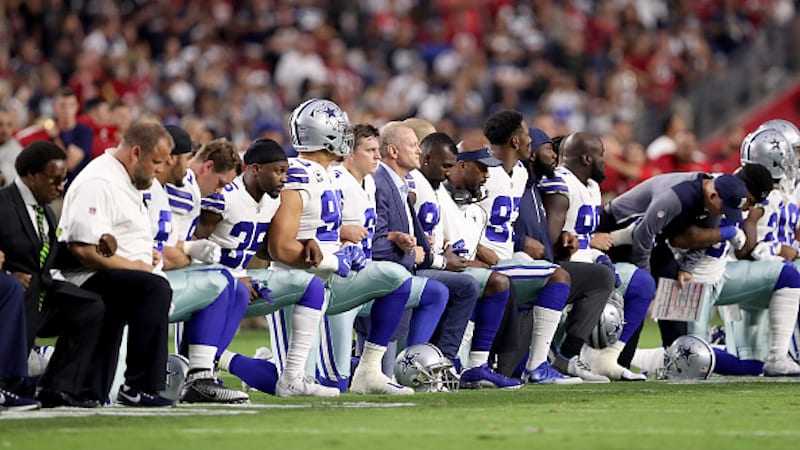As the Pledge of Allegiance plays over the intercom, I customarily stand and watch my students stand with me. This year for the first time in my teaching career, I noticed a student who remained seated throughout the entire pledge. As a student of color in a predominately white school, I knew immediately why he might be choosing to sit. A week later I noticed him in the hallway engaged in a passionate discussion with another student who claimed that he hated America because he refused to stand. This is all to say—I have attempted to navigate the larger discussion stemming from the “Take A Knee” movement in the NFL for three years now.
Colin Kaepernick’s original protest has now been taken out of context in so many ways it is hard to pinpoint the issue that we are addressing here. So let’s clarify. Kaepernick’s original protest was completely about police brutality. It evolved from sitting during the national anthem to kneeling because he wanted to honor veterans. Regardless how you feel about what the protest was or is, I believe there are ways you can discuss “Take a Knee” to foster understanding and unity in your classroom. Here are some resources that may help:
1. The Barnga Game
The best way to begin here is not by telling students about racial and cultural disparities. Show them. Students learn far more from experience than lecture.
Imagine you join a card game 5 minutes after everyone has started playing. No one is speaking but they all seem to know the rules of the game. You don’t know how to ask about the rules before you are dealt your hand because every time you speak you are scolded. After this round ends you lose. If you played that game 1,000 times you would probably lose every time. It would be easier if someone just told you the rules to the game. You may have just experienced for the first or the hundredth time what marginalization feels like.
This is the Barnga game. I use it to get students to understand that the unwritten rules of culture sometimes unfairly and unevenly advantage certain groups of people. This is the first step towards helping students see how different cultures may experience the world around them. Once a student can accept this, we are closer to discussing taking a knee during football games.
2. The Culture of Power
The term “culture of power” was coined in 1988 by current Executive Director of the Center for Urban Education and Innovation at Florida International University, Lisa Delpit. The Culture of Power represents a set of values, beliefs, ways of acting that unfairly and unevenly privilege groups of people based on aspects of their identities. Teaching students about this type of power structure really helps students understand the ways in which those who choose to kneel for the national anthem feel.
Analyzing power structures in the classroom can be difficult but this, in conjunction with the Barnga game is a really effective way to give students a picture of what it is like for those who feel marginalized.
3. The Invisible Knapsack
If the Culture of Power or the Barnga game prove too heavy for you, here is a way to unify your classroom by identifying the ways that we are all different. Scholar and activist, Peggy McIntosh, created the Invisible Knapsack as a way to teach about white privilege. As I have had to opportunity to teach various populations of students, I have adapted the invisible knapsack for my own purposes. I use it to teach every student that they can claim privilege and power in the world based on specific aspects of their identity.
For this exercise I give students a sheet of paper with a printed backpack on it. I challenge them to fill the backpack with every piece of their identity that gives them an advantage in the world. Once students see how full their backpacks and others backpacks are, it changes they way they view themselves and the world around them. When addressing the “Take a Knee” movement, it is imperative that we show students the power and privilege in everyone’s identities.
4. Address the elephant in the room
Just have the conversation in class. It may be a tough one but it can be academic as well as transformative. I use a method called the Harkness method in my class. It is a round table, open forum in which students lead the entire discussion. As the teacher, I sit at the table (or in the circle) with them and help guide or address concerns when needed. This works best when there is a text to use.
One of my favorite sites to pull academic texts from is newsela.com . They have articles about almost everything, including the “Take A Knee” movement. More than that they have discussion questions that you can use as well.
This discussion won’t be easy. But in an ever changing, increasingly diverse world, it is one that is worth having in your classroom.

